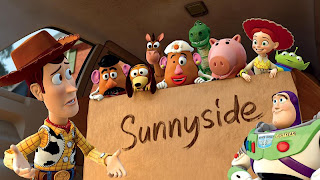
Andy is leaving for college, when all his toys are accidentally donated to Sunnyside Preschool instead of being put in the attic. Woody wants to return to Andy, but the rest of the Toys stay in Sunnyside, which by all means is a paradise for them. But things aren’t as they seem, and soon Woody has to return to save his friends and make it back before Andy leaves for College.

Hard to believe that it’s been fifteen years since Toy Story first came out. I haven’t seen it in a few years, but I remember the CGI being good back then even by today’s standards. Granted, I’d have to check it again and compare it to recent Pixar releases to be certain. Either way, back then Toy Story was a groundbreaking achievement, and now Toy Story 3 stands strong as going beyond child movie into something enjoyable for all.

First off, yes it is as good as people say it is. It follows the same spirit as the previous Toy Story movies, and develops on the themes presented in them. You will cry at the end. A lot. The climax is tense, and actually has you thinking that things won’t go according to plan. But when they do go according to plan, it feels satisfying rather than a copout.

The movie follows the basic three act structure to a T. Even a novice like me was able to pick up on the specific plot points and general flow of the plot. That being said, just because it was so noticeable didn’t detract from the movie. Instead I enjoyed it even more because I was able to see how well they used the three act structure. But that’s just me.
For everyone else the plot structure may feel familiar, but not intrusive. You won’t sit there thinking this movie is the same as every other movie (and frankly, from a basic plot element, most of them are) because Toy Story 3 has taken these characters we love, and adopted its tone slightly to suit Toy Story’s original, now young adult, audience.
There is a depressing tone overall, but in the end it’s not about how everything we love will come to an end. Instead it’s about change. How change is unavoidable, and there’s nothing we can do to stop it. And maybe that’s not a bad thing. Toy Story 3 suggests a way to come to terms with this. While everything changes, and nothing will always be the same, not all changes are for the worse. Perhaps they are heartbreaking because we no longer have what we once had and loved. But in the end the changes are just a part of life. Toy Story 3 is about acceptance. Being able to accept the change, and finding happiness despite that change and because of the change.

Toy Story 3 was not only the obvious ending for the Toy Story franchise, it was an ending that gave us the answer to fear of change that has colored the franchise from the very first movie. If you’re over twenty you will love this movie, and if you’re under twenty you will love this movie. It really is a movie for all ages.
For those of us that are over twenty and were the kids who were the target audience for the first movie. For the parents that saw the movie with their kids when it first came out and loved it. For the teenagers that saw the movie later when their older siblings or parents made them watch it, or when they watched the first movie right before the second movie came out. And for those kids that are the same age we were when we first met Woody, Buzz and the rest all those years ago.
This movie is for all of us, for the child still living in us, whether on the surface or down in the deepest part of our hearts. There may be more “sophisticated” or “adult” movies out there that some would consider more worthy of acclaim, or deeper pieces of art. I say that there are no movies worthier to be considered art than the Toy Story franchise. Like all great pieces of art, they don’t hit us over the head with symbolism or philosophy. Instead they choose a simple theme, and tie it in throughout all three movies, where it lies, ready to be recognized, but not intruding on the story in any way. For putting deeper thought into their movies, I salute you Pixar.

